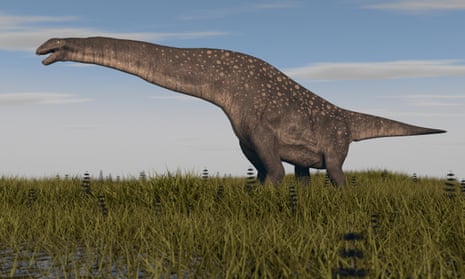It will be one of the largest exhibits to grace a British museum. In spring, the Natural History Museum in London will display the full cast of a skeleton of a titanosaur, a creature so vast it will have to be shoehorned into the 9-metre-high Waterhouse gallery.
One of the most massive creatures ever to have walked on Earth, Patagotitan mayorum was a 57-tonne behemoth that would have shaken the ground as it stomped over homelands which now form modern Patagonia. Its skeleton is 37 metres long, and 5 metres in height – significantly larger than the museum’s most famous dinosaur, Dippy the diplodocus, which used to loom over its main gallery.
“The sheer scale of this creature is extraordinary,” said museum dinosaur expert Prof Paul Barrett. “Even when you see it next to one of today’s giant animals, like an elephant, it simply dwarfs them. It’s humbling.”
The remains of Patagotitan mayorum were uncovered in 2010 when a ranch owner in Patagonia came across a gigantic thigh bone sticking out of the ground. Argentinian fossil experts later dug up more than 200 pieces of skeleton, the remains of at least six individual animals.
Casts have been made of these bones by the Museo Paleontológico Egidio Feruglio in Trelew, Patagonia, and these form the skeleton that will go on display in London in March.
“The number of bones uncovered represents a treasure trove of material,” said Sinead Marron, the exhibition’s lead curator. “It means we now know a lot more about this species than we do about many other dinosaurs.”
Patagotitan mayorum lived about 101 million years ago, during the early Cretaceous period, near the end of the dinosaurs’ reign on Earth. It was one of the three or four biggest species of titanosaur now known to science. These creatures were built like suspension bridges with a huge spine, a vast neck for gathering food from trees and a tail to provide balance.
“They were herbivores that gobbled up plants and leaves and fermented them in their vast stomachs, producing huge amounts of methane as a byproduct – so you would not want to hang around the back end of one of these animals,” Barrett said. “In fact, some people argue that plant-eating dinosaurs like these belched out so much methane they contributed to the greenhouse heating that then had the planet in its grip.”
Despite these colossal creatures weighing more than nine elephants, they started out smaller than a human baby, Marron added. “As part of the exhibition we are displaying a fossilised dinosaur egg that is about 15cm in diameter, smaller than a football,” she added. “From that, the animal grew to a length of 37 metres.”
Several mysteries still surround Patagotitan mayorum, however. “You find remains of big dinosaurs in many places but in Patagonia you get ones that are absolutely massive, like titanosaurs,” Barrett said. “So was there something special about the ecology of the region at this time or have we just been unlucky so far in not finding titanosaur remains elsewhere?”
It is also not clear why the six animals died so close together. “They were all almost fully grown and died at the same site,” Marron said. “But why? What could have done that? It is not clear, though the mystery gives an extra dimension to the story of these wonderful animals.”
Titanosaur: Life as the biggest dinosaur opens on 31 March next year until 7 January 2024.
This article was amended on 27 November 2022. Patagotitan mayorum lived about 101 million years ago, during the early Cretaceous period; not about 100 million years ago, during the late Cretaceous period, as an earlier version said.










